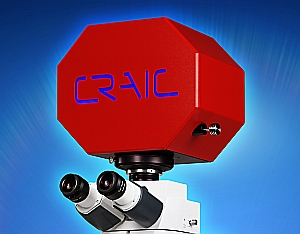CRAIC Technologies, the leading manufacturer of UV-visible-NIR microscopes and microspectrometers, is pleased to announce the 308 FPD: a spectrophotometer designed to analyze the color and relative intensity of individual pixels of even microdisplays.
The system attaches to a probe station or microscope to enable you to obtain color data and relative intensity comparisons for flat panel displays of all types. Also able to measure spectra on the micron scale, the 308 FPD can map the variations due to mura, perform pixel-to-pixel comparisons and can even map spectral variations within a single pixel. With addition of CRAIC Technologies QDI FilmPro software, the 308 FPD can also measure thin film thickness and even cell gap thickness. This provides the display makers with an unparalleled capability to optimize and improve their flat panel display manufacturing process with a multi-faceted test solution: the 308 FPD spectrophotometer.

"Many of our customers want to measure ever smaller features on flat panel displays. With our experience of spectroscopy and imaging on the micron scale, developing the 308 FPD was a logical step for CRAIC Technologies" says Dr. Paul Martin, President. "The 308 FPD features our proprietary Lightblades spectrophotometers technology for improved performance and enhanced flexibility. This system allows for colorimetry, spectroscopy and intensity measurements on the micron scales that are common to advanced high resolution displays. The 308 FPD can also be configured to measure thin film thickness as well as for imaging. This allows for testing of many aspects of displays with a single instrument."
The 308 FPD solution combines advanced Lightblades spectrophotometers with sophisticated optics and software to enable the user to measure spectra, colorimetry, light intensity and film thickness on the micron scale. As the smallest pixels are now on the order of 10 microns across, the 308 FPD provides the ability to not only measure the color and intensity of the entire display but also to compare pixels to pixels and even map out the changes within a single pixel. Designed for the production environment, it can incorporate automated measurement capabilities, touch screen controls, easily modified processing recipes and sophisticated data analysis tools.